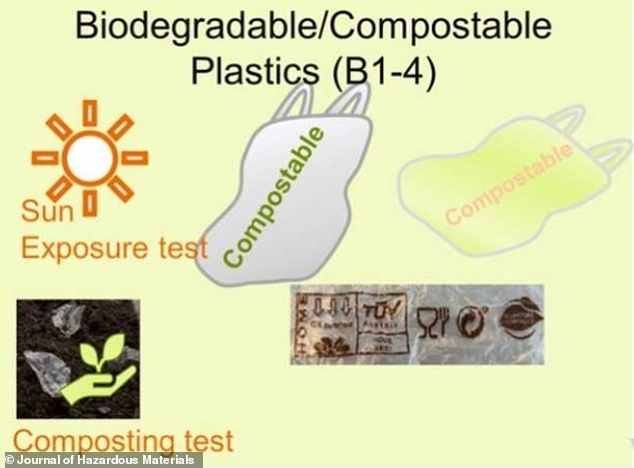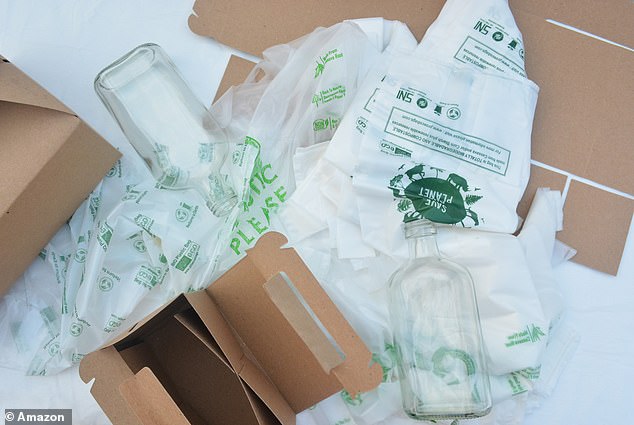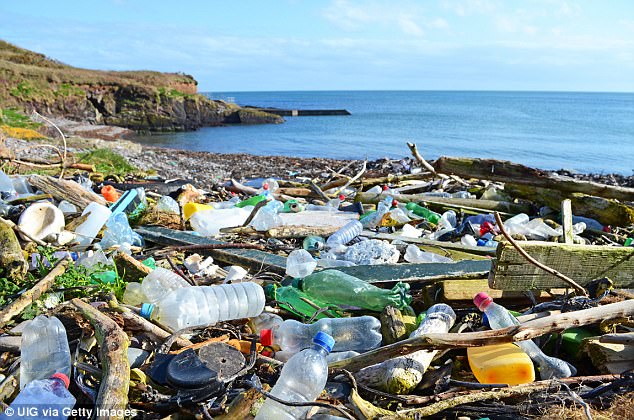Biodegradable carrier bags are more toxic than conventional plastic versions, research claims
Biodegradable plastic carrier bags are more toxic than conventional plastic bags, a new study has found.
Researchers analyzed three types of bags: a compostable bag made from vegetable starch, a recycled plastic bag and a conventional plastic bag.
They exposed them to sunlight to help them break down, and then exposed them to fish cells.
They then also composted them and tested the resulting compost for toxicity.
According to the authors from the Spanish National Research Council (CSIC), the biodegradable bags caused a ‘high level of toxicity’, damaging the fish cells.
Researchers found a high level of toxicity in compostable plastic bags, which increases with photodegradation (the change of the plastic material by ultraviolet light)
Cinta Porte, lead author of the study, published in the Hazardous Materials Journalsaid: ‘We were surprised that cells exposed to conventional plastic bags showed no trace of toxicity.
‘However, we did find it in biodegradable specimens, which reduced cell viability.
‘Our hypothesis is that manufacturers are adding chemical additives to make biodegradable bags that can be particularly toxic.
‘Additionally, recycled plastic bags also showed higher toxicity than conventional bags, as plastic additives would also be added for reuse.’
In the experiment, the aging process of the bags was simulated with ultraviolet radiation (photodegradation).
The small fragments of the bags remaining after composting and the compost resulting from bag breakdown were analyzed.
The study found that toxins “result in the accumulation of pollutants that can affect the environment and negatively impact the health of the population.”

Researchers analyzed three types of bags: a compostable plastic bag made from vegetable starch, a recycled plastic bag and a conventional plastic bag. They exposed them to sunlight to help them break down, and then exposed them to fish cells
Amparo Lopez Rubio, co-author, said: ‘The observed toxicity could come from both the additives used during processing and the fragments of biodegradable plastic produced during composting.’
‘It is necessary to thoroughly investigate the migration and ecotoxicity of these new materials and establish a proper regulatory framework, based on scientific evidence, to ensure their safety before they reach the market.
‘We need open and transparent interaction with the companies that will allow us to make progress in developing materials that are not only more sustainable, but also safe.’
The authors said the specific chemical compounds added to these compostable bags could not be identified in the study because many additives are protected by patents.
But they are probably plasticizers: compounds added to the plastic to make it more flexible.
The researchers tested four different types of compostable bags: made from polybutylene adipate teraptalate and starch, a single-use water bottle made from PET (polyethylene teraptalate), a conventional plastic bag made from LDPE (low density polyethylene) and two garbage bags made from recycled polyethylene. .

Compostable bags are often advertised as ‘eco-friendly’ with slogans like ‘save the planet’ – but their green properties can be overstated
Tiantian Wang, first author of the study, said: ‘Although each manufacturer may add different additives to their products, we found that all biodegradable bags have a similar level of toxicity.’
The researchers conclude: ‘This work demonstrates the increased toxicity of recycled plastics, compostable plastics and semi-degraded compostable plastics due to partial disintegration, compared to new conventional plastic extracts.
‘These findings underscore the need for additional research efforts and the implementation of regulatory measures before mature compost is released into the environment.’
Last year, researchers in Manchester reported that compostable bags have almost twice as much impact on global warming as traditional plastic, and four times as much as paper.
Although compostable bags can only break down properly under high temperatures in special processing plants, they are usually thrown away with general waste before being sent to landfill where methane is released, the experts said.

